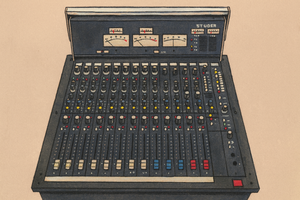Mischen im analogen Bereich
Mischen im analogen Bereich
Den verlorenen Zauber wiederentdecken
Von Frans de Rond, Ingenieur bei Sound Liaison
Als ich meine Karriere als Toningenieur begann, zeichneten sich die ersten digitalen Technologien gerade erst ab. Doch in jenen frühen Jahren war meine Welt noch völlig analog. Aufnehmen bedeutete, ein Mikrofon zu platzieren, es durch ein Mischpult zu leiten und auf einer Mehrspur-Bandmaschine aufzunehmen. Mischen hieß, dieses Mehrspurband erneut durch das Mischpult laufen zu lassen und ein Stereo-Master auf einer Zweispur-Bandmaschine zu erstellen. Der gesamte Prozess war haptisch, unmittelbar und eng mit dem physischen Medium verbunden.
Dann kam die digitale Revolution. Mit dem Aufkommen der ersten digitalen Workstations schienen die Möglichkeiten grenzenlos. Plötzlich konnte man Klänge auf nie dagewesene Weise bearbeiten. Noten ließen sich perfekt ausrichten, die Tonhöhe präzise korrigieren und mit einer riesigen Auswahl an Plug-ins den Klang mithilfe von EQ, Kompression und Effekten formen. Die meisten dieser Plug-ins waren (und sind es immer noch) klassischen analogen Geräten nachempfunden. Damals gab es Bedenken hinsichtlich der Klangqualität, doch die digitale Signalverarbeitung hat sich über die Jahrzehnte enorm weiterentwickelt.
Vierzig Jahre später ist eine ganze Generation von Toningenieuren herangewachsen, die ausschließlich digital arbeitet. Viele von ihnen haben nie erlebt, wie es ist, komplett analog aufzunehmen und zu mischen. Und so verschwindet dieser besondere „Sound“ – der analoge Zauber – langsam aus unserem kollektiven Gedächtnis.
Musikliebhaber, die noch Vinylplatten auf einem hochwertigen Plattenspieler abspielen, wissen, wovon ich spreche. Da ist eine Präsenz, eine Wärme, eine emotionale Unmittelbarkeit, die sich von der polierten Präzision des Digitalen unterscheidet.
Dieses Jahr, als ich mit den Aufnahmen begann DSD256 bei Sound Liaison , ich habe eine Entscheidung getroffen, die mich zu meinen Wurzeln zurückgeführt hat: Ich habe ein komplett überholtes System installiert Studer 961 Konsole ( vintagetools.de ) Ich nutzte es zum Abhören und Mischen. Die Qualität dieses 40 Jahre alten Mischpults hat mich umgehauen. Der Klang beim Abspielen war so inspirierend, dass ich beschloss, den kompletten Mix ebenfalls über das Studer-Pult aufzunehmen. 
Und was dann geschah, überraschte selbst mich. Im Vergleich zum reinen PCM-Mixing kehrte etwas Unfassbares zurück. Etwas, das ich nur als vertraut beschreiben konnte, einen Klang aus der Vergangenheit, einen Klang, den wir irgendwie im Laufe der Zeit verloren hatten.
Mir wurde plötzlich klar: Geblendet von den grenzenlosen Möglichkeiten digitaler Aufnahme und Mischung hatten wir unbewusst etwas Wertvolles weggeworfen. Mit der Studer in der Kette, Klang und die Mojo waren zurück.
Das Erlebnis ist fast überwältigend. Es fühlt sich an, als höre man ein fertiges Album und nicht eine Session, die noch Feinschliff benötigt. Anstatt endlos nach Details zu suchen, übernimmt die Musik selbst die Führung. Sie hat einen natürlichen Fluss, eine Tiefe und eine Dreidimensionalität, die einen einfach in ihren Bann zieht.
Manchmal frage ich mich: Bilde ich mir das alles nur ein? Sehne ich mich nach etwas, das gar nicht existiert? Aber immer wieder bestätigen es die Musiker selbst.
Vor einigen Wochen, Schlagzeuger Bruno Castellucci Er saß auf der Couch im Studio und hörte sich die Wiedergabe an. Nach ein paar Minuten drehte er sich zu mir um und sagte: „Mann, der Sound, den ich in den 90ern verloren habe, ist wieder da.“ Das jagte mir eine Gänsehaut über den Rücken. Denn ich wusste genau, was er meinte.
Und wo wir gerade von Gänsehaut sprechen, die ist mittlerweile normal geworden, wenn man sich eine Folge ansieht. DSD256-Aufnahme mit der Studer 961. Immer wieder reagieren Musiker und Zuhörer gleichermaßen körperlich auf den Klang. Es ist nicht einfach nur „eine gute Aufnahme“ oder „eine emotionale Darbietung“. Da ist noch etwas mehr, etwas Schwerer Definierbares. Bei PCM-Aufnahmen empfanden wir eine Aufnahme oft als stark, aber es blieb immer ein subtiles Gefühl, dass etwas fehlte. Mit der Studer und DSD256 offenbart sich dieses fehlende Element plötzlich.
Es ist wie mit der bekannten Geschichte der amerikanischen Ureinwohner, die Kolumbus' Schiffe bei ihrem ersten Erscheinen nicht erkannten, einfach weil ihnen der Vergleich mit solchen Schiffen fehlte. Genauso nehmen viele von uns den Zauber analoger Musik nicht mehr wahr, weil wir ihn nie erlebt oder vergessen haben, wie er klingt. Doch sobald man ihn wieder hört, weiß man sofort, was verloren gegangen war.
Bei Sound Liaison – wir haben eine Leidenschaft dafür, Aufführungen mit höchstmöglicher Klangtreue festzuhalten. DSD256 Technologie wird kombiniert und nun auch die analoge Welt des Mischens einbezogen. Die Kombination ist atemberaubend. Es ist, als ob das Beste aus beiden Welten – die Präzision moderner digitaler Aufnahmen und die Seele des analogen Mischens – auf zeitlose und zugleich innovative Weise zusammenkommen.
Für mich ist analoges Mischen keine Frage der Nostalgie. Es geht darum, eine Authentizität wiederzuentdecken, die allzu oft unter digitaler Perfektion begraben wird. Es geht um Klang, der einen berührt, noch bevor man den Grund dafür erkennt. Es geht darum, Gänsehaut zu erzeugen.
Und diese Reise hat gerade erst begonnen.
Fortgesetzt werden…

